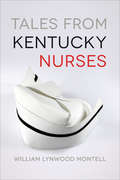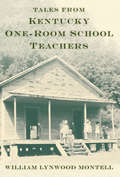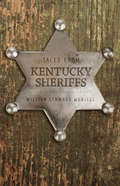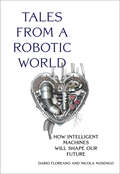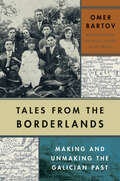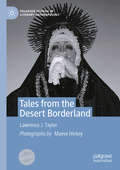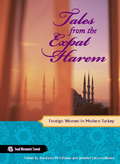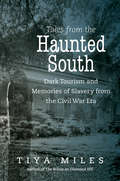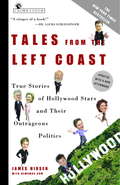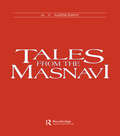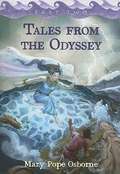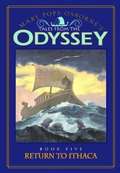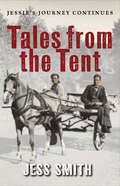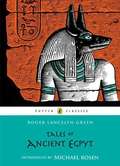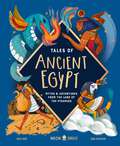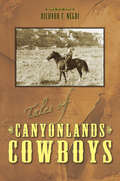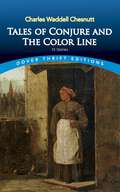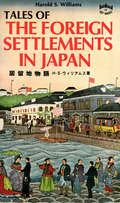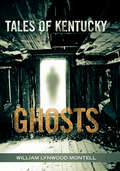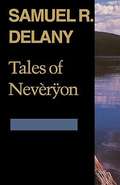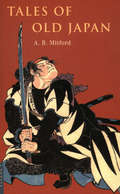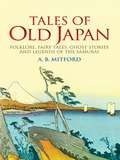- Table View
- List View
Tales from Kentucky Nurses
by William Lynwood MontellThis oral history shares stories of Kentucky nurses—from frontier births to emergency rooms and from the early twentieth-century to the present day. From frontier times to the present day, Kentucky nurses have served with intelligence and energy, always ensuring that their patients received the best available care. Folklorist and oral historian William Lynwood Montell collects nearly two hundred stories from these hard-working men and women in Tales from Kentucky Nurses. From humorous anecdotes to spine-chilling coincidences, tragic circumstances, and heartwarming encounters, the tales in this lively volume are recorded exactly as they were told to Montell. This collection features anecdotes from the famous Frontier Nursing Service, which provided essential care to families in remote areas of the state and whose leader, Mary Breckinridge, is remembered for her wit and kindness. In addition, Montell's interviewees share ghost stories and describe folk remedies like the practice of placing an axe under a woman's pillow during labor to cut the pain. These firsthand accounts not only pay homage to an underappreciated profession but also preserve important aspects of Kentucky's history not likely to be recorded elsewhere.
Tales from Kentucky One-Room School Teachers
by William Lynwood MontellThis colorful collection of stories celebrates a fascinating aspect of Kentucky&’s cultural heritage in &“a fascinating look back at a bygone era&” (Kentucky Monthly). In an educational era defined by large school campuses and overcrowded classrooms, it is easy to overlook the era of one-room schools, when teachers filled every role, including janitor, and provided a family-like atmosphere in which children also learned from one another. In Tales from Kentucky One-Room School Teachers, oral historian William Lynwood Montell reclaims an important part of Kentucky's social, cultural, and educational heritage, assembling a fascinating collection of schoolroom stories. The firsthand narratives and anecdotes in this collection cover topics such as teacher-student relationships, day-to-day activities, lunchtime foods, students' personal relationships, and, of course, the challenges of teaching in a one-room school. Montell includes tales about fund-raising pie suppers, pranks, outrageous student behavior—such as the quiet little boy whose first &“sharing&” involved profanity—and many other topics. Montell even includes some of his own memories from his days as a pupil in a one-room school.
Tales from Kentucky Sheriffs
by William Lynwood Montell“Wildly funny and deeply tragic . . . these tales chronicle each sheriff’s journey from youth to election to office and, occasionally, into retirement.” —Wayne County OutlookFollowing the success of his collections of stories from funeral directors, schoolteachers, doctors, and lawyers, folklorist William Lynwood Montell presents a new volume of tales from Kentucky sheriffs. Montell collected stories from all areas of the state to represent the diversity of social and economic backgrounds in the various communities the officers serve.Tales from Kentucky Sheriffs covers elections, criminal behavior, and sheriff’s mistakes in a lighthearted and often humorous manner. The book includes accounts of a drunk driver who thought he was in a different state, a sheriff running a sting operation with the US Marshals, and a woman reporting a tomato thief in her garden. Other accounts involve procedural errors with serious consequences, such as the tale of a sheriff who mistakenly informs a man that his son has committed suicide. Together, these firsthand narratives preserve important aspects of Kentucky’s history not likely to be recorded elsewhere.“The stories Montell collected fill up nearly 300 pages and range from humorous mishaps during incidents and interesting criminal behavior to the more somber topic of death in the line of duty.” —Central Kentucky News-Journal“The numerous experiences shared by the people interviewed cover several decades and provide a very enlightening look into the world of Kentucky county-level law enforcement.” —Kentucky Ancestors“[Montell] has once again mined an important element of the state’s culture with utter transparency, and has—once again—done the state proud.” —Kentucky Monthly
Tales from a Robotic World: How Intelligent Machines Will Shape Our Future
by Dario Floreano Nicola NosengoStories from the future of intelligent machines—from rescue drones to robot spouses—and accounts of cutting-edge research that could make it all possible.Tech prognosticators promised us robots—autonomous humanoids that could carry out any number of tasks. Instead, we have robot vacuum cleaners. But, as Dario Floreano and Nicola Nosengo report, advances in robotics could bring those rosy predictions closer to reality. A new generation of robots, directly inspired by the intelligence and bodies of living organisms, will be able not only to process data but to interact physically with humans and the environment. In this book, Floreano, a roboticist, and Nosengo, a science writer, bring us tales from the future of intelligent machines—from rescue drones to robot spouses—along with accounts of the cutting-edge research that could make it all possible. These stories from the not-so-distant future show us robots that can be used for mitigating effects of climate change, providing healthcare, working with humans on the factory floor, and more. Floreano and Nosengo tell us how an application of swarm robotics could protect Venice from flooding, how drones could reduce traffic on the congested streets of mega-cities like Hong Kong, and how a &“long-term relationship model&” robot could supply sex, love, and companionship. After each fictional scenario, they explain the technologies that underlie it, describing advances in such areas as soft robotics, swarm robotics, aerial and mobile robotics, humanoid robots, wearable robots, and even biohybrid robots based on living cells. Robotics technology is no silver bullet for all the world&’s problems—but it can help us tackle some of the most pressing challenges we face.
Tales from the Borderlands: Making and Unmaking the Galician Past
by Omer BartovThe story of the diverse communities of Eastern Europe&’s borderlands in the centuries prior to World War II &“A powerful combination of history and personal memoir . . . A richly contextual, skillfully woven historical study.&”—Kirkus Reviews (starred review) Focusing on the former province of Galicia, this book tells the story of Europe&’s eastern borderlands, stretching from the Baltic to the Balkans, through the eyes of the diverse communities of migrants who settled there for centuries and were murdered or forcibly removed from the borderlands in the course of World War II and its aftermath. Omer Bartov explores the fates and hopes, dreams and disillusionment of the people who lived there, and, through the stories they told about themselves, reconstructs who they were, where they came from, and where they were heading. It was on the borderlands that the expanding great empires—German, Austro-Hungarian, Russian, and Ottoman—overlapped, clashed, and disintegrated. The civilization of these borderlands was a mix of multiple cultures, languages, ethnic groups, religions, and nations that similarly overlapped and clashed. The borderlands became the cradle of modernity. Looking back at it tells us where we came from.
Tales from the Desert Borderland (Palgrave Studies in Literary Anthropology)
by Lawrence J. TaylorTaylor brings an ethnographer’s eye, ear, and many years of experience to this fictional portrait of life along the US/Mexico desert border. In these linked short stories, readers are taken on a wild ride from San Diego to Nogales, into Mexican and Chicano neighborhoods, failed spas and defunct mining towns, rambling Native American reservations and besieged Wildlife Refuges. Along the way they will share the conflicts, calamities, and occasional triumph of an engaging cast of characters. While these tales treat such familiar border themes as drug- and people-smuggling or hybrid and conflicting cultures and identities, they do so with a literary flair that revels in the rich diversity of border life as well as in its ambiguity, ambivalence, irony and often unexpected humor.
Tales from the Expat Harem: Foreign Women in Modern Turkey
by Jennifer Eaton Gökmen Anastasia M. AshmanAs the Western world struggles to comprehend the paradoxes of modern Turkey, Tales from the Expat Harem reveals its most personal nuances. This illuminating anthology provides a window into the country from the perspective of thirty-two expatriates from seven different nations-artists, entrepreneurs, Peace Corps volunteers, archaeologists, missionaries, and others-who established lives in Turkey for work, love, or adventure. Through narrative essays covering the last four decades, these diverse women unveil the mystique of the "Orient," describe religious conflict, embrace cultural discovery, and maneuver familial traditions, customs, and responsibilities. Poignant, humorous, and transcendent, the essays take readers to weddings and workplaces, down cobbled Byzantine streets, into boisterous bazaars along the Silk Road, and deep into the feminine stronghold of steamy Ottoman bathhouses. The outcome is a stunning collection of voices from women suspended between two homes as they redefine their identities and reshape their worldviews.
Tales from the Haunted South: Dark Tourism and Memories of Slavery from the Civil War Era (The Steven and Janice Brose Lectures in the Civil War Era)
by Tiya MilesIn this book Tiya Miles explores the popular yet troubling phenomenon of "ghost tours," frequently promoted and experienced at plantations, urban manor homes, and cemeteries throughout the South. As a staple of the tours, guides entertain paying customers by routinely relying on stories of enslaved black specters. But who are these ghosts? Examining popular sites and stories from these tours, Miles shows that haunted tales routinely appropriate and skew African American history to produce representations of slavery for commercial gain. "Dark tourism" often highlights the most sensationalist and macabre aspects of slavery, from salacious sexual ties between white masters and black women slaves to the physical abuse and torture of black bodies to the supposedly exotic nature of African spiritual practices. Because the realities of slavery are largely absent from these tours, Miles reveals how they continue to feed problematic "Old South" narratives and erase the hard truths of the Civil War era. In an incisive and engaging work, Miles uses these troubling cases to shine light on how we feel about the Civil War and race, and how the ghosts of the past are still with us.
Tales from the Left Coast: True Stories of Hollywood Stars and Their Outrageous Politics
by James HirsenWhen Barbra Streisand sends Dick Gephardt a personal fax, it makes headline news. When international relations expert Sean Penn leads his own "tour of peace" in Baghdad, every news desk across the country reports it. It's no secret that Hollywood has a leftward tilt when it comes to politics. But what the celebrity-fawning media fail to show is how Hollywood's liberal bias affects actors, movies, and even public policy. In Tales from the Left Coast, author and political commentator James Hirsen digs deep into the liberal underbelly of Hollywood to reveal how biased politics have corrupted the entire entertainment industry. Through extensive research and scores of interviews, Hirsen uncovers some of the most ridiculous, infuriating, and damning political stunts pulled by celebrities of yesterday and today, and he traces the tangled web of influence the Hollywood elite have over politicians in Washington, D.C.
Tales from the Masnavi (Routledge Revivals: Selected Works Of A. J. Arberry Ser. #6)
by A. J ArberryThe Masnavi of Jalal al-Din Rumi (1207-1273), a massive poem of some 25,000 rhyming couplets, by common consent ranks among the world's greatest masterpieces of religious literature. The material which makes up the Masnavi is divisible into two different categories: theoretical discussion of the principal themes of Sufi mystical life and doctrine, and stories of fables intended to illustrarte those themes as they arise. This selection of tales is the most accessible introduction to this giant epic for the non-perisan reader.
Tales from the Odyssey
by Mary Pope OsborneAfter twenty years of fighting monsters, angering gods and goddesses, and surviving against the odds, Odysseus is more desperate than ever to return to his family. But first he will have to explore yet another strange land. And when he finally does return home, he will have yet more dangerous enemies to face. This is the exciting conclusion to the series by best-selling author Mary Pope Osborne, retelling Homer's Odyssey, one of the most thrilling adventure stories of all time. This volume includes: Book Four: The Gray-Eyed Goddess Book Five: Return to Ithaca Book Six: The Final Battle
Tales from the Odyssey #5: Return to Ithaca
by Mary Pope OsborneAfter struggling against the gods and his fate for more than twenty years, Odysseus has returned to Ithaca at last. But things have changed: what used to be his island has been overrun by suitors who clamor for his wife's hand in marriage and plague his son, Telemachus. With the help of the gray-eyed goddess, Athena, Odysseus and Telemachus must set out to regain control of Ithaca. In these books based on episodes from Homer's Odyssey, Mary Pope Osborne brings to life the exciting adventures of one of the greatest heroes of all time.
Tales from the Odyssey (Part #1)
by Mary Pope OsborneOdysseus is far from home, tossed by stormy seas and cursed by an angry one-eyed giant. After twenty years of fighting monsters, angering gods and goddesses, and surviving against the odds, Odysseus returns home and faces more dangerous enemies.
Tales from the Tent: Jessie's Journey Continues
by Jess SmithFrom the author of Jessie&’s Journey, a memoir of finding her own way in the world after growing up in a family of Scottish travellers. As Tales from the Tent begins, Jess Smith has left school, and after a miserable spell working in a paper mill, she abandons the settled life and takes to the roads once more. The old bus she lived in as a child has gone, to be replaced by a caravan and campsites. Times are changing, and it is becoming harder and harder for travellers to make a living by doing the rounds of seasonal jobs like berry-picking. Conscious that the old way of life was disappearing before her eyes, Jess stored up as much as she could gather from the rich folklore of the travellers&’ world. Now she retells some of the many stories and songs she heard by the campfire or at the tent&’s mouth. Interwoven with these tales is the story of Jess and her life on the road—her first loves, her friendships, her days hawking and berry-picking, the exploits of her lovable but infuriating family, and the unforgettable characters she meets.Praise for the trilogy: &“Skillfully takes her reader into the world of Scottish Travellers in her own down-to-earth, straight-from-the-heart manner.&” —Travellers' Times &“Heartwarming reminiscences.&” —Sunday Post
Tales of Ancient Egypt
by Roger Lancelyn GreenThis book on ancient Egypt is separated out into three sections: tales of the gods, tales of magic, and tales of adventure.
Tales of Ancient Egypt: Myths & Adventures from the Land of the Pyramids (Tales of)
by Neon Squid Hugo D. CookDiscover amazing true stories and breathtaking myths from ancient Egypt in this book by TikTok Egyptologist Hugo D. Cook, featuring stunning illustrations from Sona Avedikian.Everyone knows the story of Tutankhamun, but the ancient Egyptian civilization lasted for more than 3,000 years—which means there are loads more amazing tales to be told! Egyptologist and TikTok star Hugo D. Cook (aka Hugo the Egyptologist) has scoured ancient texts and translated hieroglyphs to bring readers stories of love, betrayal, and royal scandal featuring pharaohs, priests, gods, and goddesses. The book combines historical stories, including the time Cleopatra hid in a sack to be smuggled into a palace to meet Julius Caesar, with rip-roaring myths, like the Cinderella story of a peasant girl who married the pharaoh when he found her slipper. Readers will also be awed by incredible lesser-known stories such as:• How Ramses the Great dealt with a horde of mysterious pirates• The real story of a queen's cunning plot to assassinate the king• The shapeshifting wizard-king who defended Egypt with magic boatsTold with great fun and impeccably researched, readers will slip into a tomb at night with a band of mischievous tomb robbers and witness epic battles featuring elephants and ostriches. Interspersed through the stories are pages explaining the history of ancient Egypt on the banks of the Nile, from how pyramids were built to a step-by-step guide to wrapping a mummy.With a beautiful cloth-textured cover featuring shiny foil, Tales of Ancient Egypt is the perfect gift for kids interested in ancient Egypt.
Tales of Canyonlands Cowboys
by Richard NegriRichard Negri interviews cattlemen and women about ranching in the rugged canyonlands region of southeastern Utah. Personal stories and anecdotes from the colorful characters who ground out a hard living on ranches of the are in the early twentieth century.
Tales of Conjure and The Color Line: 10 Stories (Dover Thrift Editions: Black History)
by Charles Waddell ChesnuttOutstanding, affordably priced volume presents a selection of 10 best stories by a pioneer in the development of African-American fiction: "The Goophered Grapevine," "Po' Sandy," "Sis' Becky's Pickaninny," "The Wife of His Youth," "Dave's Neckliss," "The Passing of Grandison," "A Matter of Principle," "The Sheriff's Children," "Baxter's Procrustes," and "The Doll." Redolent with wit, charm, and insight; essential reading for students of African-American culture. Edited and with an Introduction by Joan Sherman.
Tales of Foreign Settlements in Japan
by Harold S. WilliamsHere are twenty-five tales about the Foreign Settlements or Concessions in Japan following the opening of the country to foreign trade in 1859, and an additional ten strange stories that revoke around those times. <P><P>The tales are historically accurate, sociologically significant and, most important of all, eminently readable.These Tales of Foreign Settlements in Japan are the product of years of painstaking and scholarly research by a writer who is a business man and a recognized authority on the history of the Foreign Concessions in Japan, a man who has resided here for over thirty-five years.
Tales of Gotham, Historical Archaeology, Ethnohistory and Microhistory of New York City
by Meta F. Janowitz Diane DallalHistorical Archaeology of New York City is a collection of narratives about people who lived in New York City during the seventeenth, eighteenth, and nineteenth centuries, people whose lives archaeologists have encountered during excavations at sites where these people lived or worked. The stories are ethnohistorical or microhistorical studies created using archaeological and documentary data. As microhistories, they are concerned with particular people living at particular times in the past within the framework of world events. The world events framework will be provided in short introductions to chapters grouped by time periods and themes. The foreword by Mary Beaudry and the afterword by LuAnne DeCunzo bookend the individual case studies and add theoretical weight to the volume. Historical Archaeology of New York City focuses on specific individual life stories, or stories of groups of people, as a way to present archaeological theory and research. Archaeologists work with material culture--artifacts--to recreate daily lives and study how culture works; this book is an example of how to do this in a way that can attract people interested in history as well as in anthropological theory.
Tales of Kentucky Ghosts
by William Lynwood Montell“Vividly re-creates the context of storytelling in Kentucky in times past.” —Margaret Read MacDonald, author of Ten Traditional TellersA good ghost story can make your hair stand on end, your palms sweat, and your heart race. The bone-chilling collection Tales of Kentucky Ghosts presents more than 250 stories that do just that. William Lynwood Montell has assembled an entertaining and diverse array of tales from across the commonwealth that will keep you checking under the bed every night. The first-person accounts in this collection showcase folklore that Montell has drawn from archives, family stories, and oral traditions throughout Kentucky. The stories include that of the ghost bride of Laurel County, who appears each year on the anniversary of her wedding day; the tale of the murdered worker who haunts the Simpson County home of his killer and former employer; the account of the lost mandolin that plays itself in a house in Graves County, and many more. Tales of Kentucky Ghosts brings together a variety of terrifying narratives that not only entertain and frighten but also serve as a unique record of Kentucky’s rich heritage of storytelling.“Lynwood Montell is truly an icon in the field of Kentucky folklore.” —James McCormick and Macy A. Wyatt, authors of Ghosts of the Bluegrass“Lynwood Montell successfully reports on family stories, bizarre creatures, urban legends, classic country ghost tales, strange glowing lights, talking cats and so much more.” —Thomas Freese, author of Ghosts, Spirits, and Angels: True Tales from Kentucky and Beyond“Sure to both entertain and chill its readers while also allowing them to consider their own supernatural heritage.” —Manchester Enterprise
Tales of Minoa and Apocalypse: From Athens to Ancient Japan
by Toru NakamuraThis book presents the following: the facts and myths concerning Minoa; the catastrophic earthquakes, tsunami, and volcanic eruption in the Aegean Sea; Greece before and after its Dark Ages; and their historical connection with Japan’s ancient society. So
Tales of Neveryeon
by Samuel R. DelanyIn his four-volume series Return to Neveryeon, Hugo and Nebula award-winner Samuel R. Delany appropriated the conceits of sword-and-sorcery fantasy to explore his characteristic themes of language, power, gender, and the nature of civilization. Wesleyan University Press has reissued the long-unavailable Neveryeonvolumes in trade paperback.The eleven stories, novellas, and novels in Return to Neveryeon's four volumes chronicle a long-ago land on civilization's brink, perhaps in Asia or Africa, or even on the Mediterranean. Taken slave in childhood, Gorgik gains his freedom, leads a slave revolt, and becomes a minister of state, finally abolishing slavery. Ironically, however, he is sexually aroused by the iron slave collars of servitude. Does this contaminate his mission -- or intensify it? Presumably elaborated from an ancient text of unknown geographical origin, the stories are sunk in translators' and commentators' introductions and appendices, forming a richly comic frame.
Tales of Old Japan
by A. B. MitfordFirst published in 1871, Tales of Old Japan has withstood the test of time and taken its place as one of the classic volumes of Japanese literature.The book presents a broad cross section of Japanese prose-historical tales like the famous story of the Forty-seven Ronin; nonfiction reporting on marriage, funerals and the author's gory eyewitness account of hara-kiri; fairy tales and stories of superstition featuring vampire cats and magic foxes; even three sermons written by a priest belonging to the Shingaku sect, which professes to combine Buddhist, Confucian and Shinto teachings. The books thirty-three chapters cover practically every sector of Japanese life. Thirty-one reproductions of woodblock prints illustrate the various tales and essays. Author Robert Louis Stevenson cited Tales of Old Japan in his essay "Books Which Have Influenced Me." Over a hundred years have passed since Stevenson justly praised A.B. Mitford's book, but his work remains an important and fascinating sourcebook on Japan and the Japanese.
Tales of Old Japan: Folklore, Fairy Tales, Ghost Stories and Legends of the Samurai
by A. B. MitfordThe member of a distinguished British literary family, A. B. Mitford traveled widely with his parents as a youth and lived in various European countries. From 1866-70, he served as an attaché with the British legation at Edo (Tokyo) — one of the first foreign diplomats to do so. During his brief stay there, Mitford lived through a period of dramatic and tumultuous change in Japanese history. A feudal nation on his arrival, Japan had entered the era of “Westernization” before he left some three years later. During that time, however, he quickly and thoroughly mastered the Japanese language and acted as an interpreter between the young Japanese Emperor and British royalty.Mitford’s famous collection of classic tales (the first to appear in English) covers an engrossing array of subjects: grisly accounts of revenge, knightly exploits, ghost stories, fairy tales, folklore, a fascinating eyewitness account of a hara-kiri ceremony, gripping narratives of vampires and samurai, Buddhist sermons, and the plots of four Noh plays.A treasury, as well, of information on most aspects of Japanese life, with information on locales, customs, and characters, the illustrated volume delights as it entertains, chronicling acts of heroism, devotion, ruthlessness, and chivalry that illuminate the island nation's culture.
